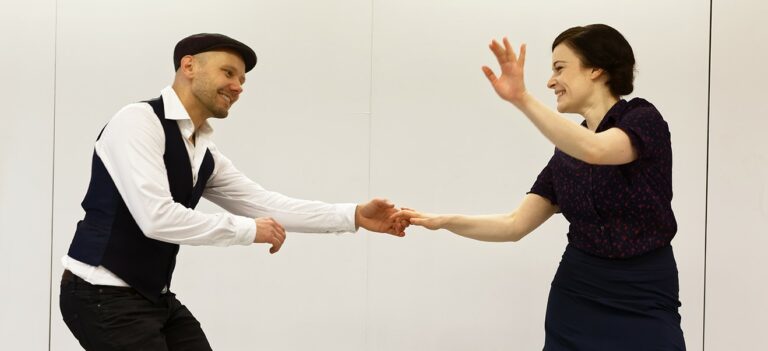Blues
A Dance of Soulful Connection and Expression
Blues dancing is an improvisational social dance that beautifully captures the essence of soulful music and deep human connection. Drawing inspiration from a rich history and a variety of musical styles, Blues dance is known for its smooth, expressive movements and its ability to connect dancers with each other and the music. Whether you are a seasoned dancer or just starting out, Blues dancing offers a unique way to explore rhythm, emotion, and creativity on the dance floor.
What is Blues Dancing?
Blues dancing is characterized by its fluid and soulful movements, including gentle turns, glides, dips, and pauses that mirror the emotional nuances of Blues music. Unlike more structured dance forms, Blues dancing thrives on improvisation, allowing dancers to interpret the music in their own way. This creates a dance experience that is deeply personal and expressive, with both the leader and the follower actively contributing to the dance.
Blues dancing is accessible to people of all ages and backgrounds, making it a wonderful choice for those who appreciate soulful and expressive music and want to experience a dance form that is both intimate and freeing.
The Rich History of Blues Dancing
Blues dancing evolved from the African American music and dance traditions at the end of the 1800s. Rooted in the social dances of African American communities, Blues dance grew alongside the development of Blues music, reflecting its rhythms, themes, and spirit. Although Blues shares some movement language with jazz dances, it has its own distinct aesthetic that emphasizes a grounded, relaxed style and a deep emotional connection to the music.
Over the decades, Blues dancing has evolved into a “family” of many different dance styles, each with its unique characteristics and flavors. These styles generally fall into two major families:
Jookin’: Originating from informal settings like juke joints, Jookin’ Blues styles are more playful, grounded, and rhythmic. Dances in this family often feature footwork variations, slides, and close partner connections.
Ballroomin’: Developed for more formal venues like ballrooms, Ballroomin’ Blues styles are characterized by a more upright posture and sweeping, elegant movements. These dances often include turns, spins, and traveling steps, creating a more graceful and flowing aesthetic.

Why Dance Blues?
Blues dancing is much more than just a series of steps; it’s a form of expression that allows you to connect deeply with the music, your partner, and yourself. Here are some reasons to try Blues dancing:
Emotional Expression: Blues dancing is all about feeling the music and expressing it through movement. It’s perfect for those who want to dance with emotion and depth, making every dance unique and personal.
Connection and Improvisation: With its focus on improvisation, Blues dancing encourages a strong, creative connection between partners. Dancers learn to listen to each other and to the music, creating a conversation that evolves with every step.
Versatility Across Music Styles: Blues dancing is incredibly versatile and can be enjoyed to a wide range of music beyond traditional Blues, including jazz, funk, soul, and even contemporary genres. This flexibility makes Blues dancing suitable for various music preferences and dance events.
Accessible and Inclusive: Blues dancing is a social dance that is accessible to all, regardless of age or dance experience. With its emphasis on feeling and connection over flashy moves, anyone can enjoy and thrive in Blues dancing.
Learn Blues in Helsinki
If you’re ready to dive into the soulful world of Blues dancing, our dance club offer beginner-friendly solo or partnered blues courses in Helsinki. Beginner level courses typically cover foundational Blues techniques, such as weight shifts, pulses, and basic turns, as well as introduce you to the different styles within the Blues family. From there, you can explore more advanced movements, musical interpretation, and partner dynamics that make Blues dancing so rich and rewarding.
Blues dancing offers a unique and meaningful way to connect with music, your dance partner, and yourself. Its emphasis on improvisation, emotional expression, and connection creates a dance experience unlike any other. Whether you are drawn to the grounded, rhythmic styles of Jookin’ Blues or the elegant, sweeping movements of Ballroomin’ Blues, there’s a style and space for you in the world of Blues dance. So, put on your dancing shoes, and let the soulful rhythms guide you on an unforgettable dance journey!
Blues dancing is an improvisational social dance that draws inspiration from a variety of musical styles. It is a social dance that can be enjoyed by people of all ages, and is great for those who appreciate soulful and expressive music.
Blues dancing is characterised by its smooth and soulful movements, often including gentle turns, glides, and dips. It is a great way to connect with a partner and enjoy music in a unique and meaningful way.
Blues evolved from the African American music and dance tradition at end of the 1800s. Although the blues movement language is partly common to jazz dances, it has its own expressive aesthetic. In Blues, both the leader and the follower actively interpret the music and take inspiration from another.
There are many styles of blues music and forms of dance. Blues is, in fact, a family of many different dance styles and most of the dance styles fall into two major families: jookin’ and ballroomin’.












